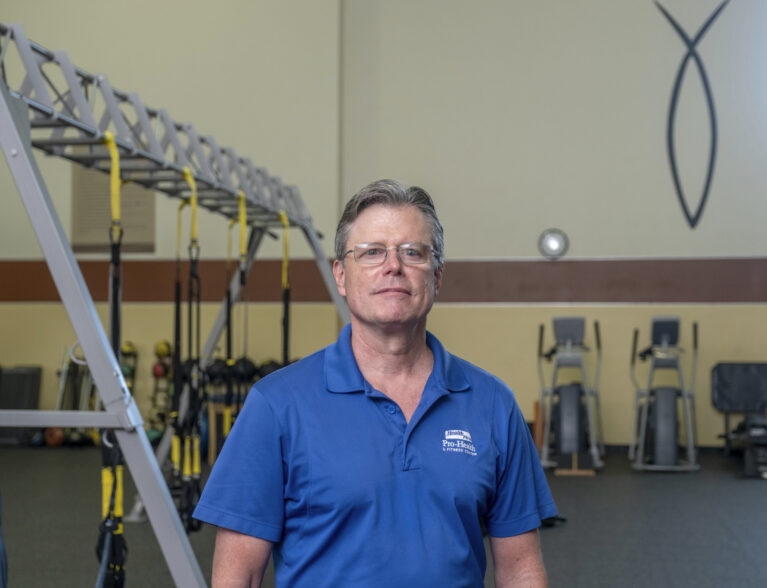
As we age, our muscle mass shrinks and strength and power decline. Known as sarcopenia – age-related muscle loss – this process begins earlier than you might think, often at about age 35.
After that, the average person loses muscle at a rate of 1 percent to 2 percent a year, until age 60, when it can accelerate to 3 percent a year.
Jim Roxburgh, a certified personal trainer at Health First’s Pro-Health & Fitness, says there’s a simple solution – get moving while you’re still young and work those muscles.
“Some people work out their whole lives. But there are others who haven’t exercised since their last high school PE class.
“Then they retire, and the doctor tells them to start to exercise and they have lots of lost time to make up.”
Roxburgh says that working out and saving for retirement are very similar – start early and you’ll have a nice nest egg.
He adds that it’s not just about lifting weights, although that is important. Balance and aerobics exercises, body weight workouts and calisthenics are excellent, too.
“Resistance training with barbells, dumbbells, kettle bells, etc., play a role. Anything that overloads muscle builds muscle and bone density,” says Roxburgh. He suggests 30 minutes of resistance training two or three times a week. “Unfortunately, no matter how much you work out you will lose some muscle mass.”
Mayo Clinic recommends a variety of exercises to maintain muscle after age 55:
- Strength exercises – Use weights or body weight as resistance to target all muscle groups.
You can try free-weight exercises like bent-over rows, biceps curls, and squats, or weight-machine exercises like biceps curls and chest presses. You can also try calisthenics like push-ups, sit-ups and jumping jacks.
- Balance exercises – Try walking heel to toe, standing on one leg, or standing up from a chair repeatedly.
- Aerobic training – Get your heart rate up with activities like dancing, biking, swimming, pickleball or walking.
Diet plays a role in muscle retention, too.
The National Institutes of Health reports that studies have investigated the association between sarcopenia and dietary patterns. Many of them showed that a Mediterranean diet with a predominant intake of vegetables, fruits, protein from legumes and omega-3 fatty acids might have the potential to reduce the risk among older adults.
Sarcopenia isn’t just an inconvenience – it can be life-changing. Cleveland Clinic’s website states that it can lead to the loss of your independence and create the need for long-term care. Sarcopenia affects your musculoskeletal system and is a major factor in increased frailty, falls and fractures, all of which can lead to hospitalizations and surgeries, which increase the risk of complications, including death.
Weak muscles put everyday activities out of reach – activities such as walking, cleaning, shopping and even dressing. They hinder your ability to cope with and recover from an illness or injury. Disability is significantly higher in older people with moderate to severe sarcopenia than in those with normal muscle mass. Weak muscles also make it harder to balance properly when moving or even standing still – and loss of power compounds the problem.
“You can’t get out of bed or a chair without help,” says Roxburgh of those with severe sarcopenia. “The most basic parts of your everyday life will be restricted.”
Web MD says that common symptoms can include weakness and loss of stamina, which can limit physical activity. Since reduced activity further shrinks muscle mass, it’s a discouraging Catch-22 situation.
Although sarcopenia is seen mostly in people who are inactive, the fact that it also occurs in people who stay physically active suggests there are other factors in its development.
Researchers believe these include:
- Reduction in nerve cells responsible for sending signals from the brain to the muscles to start movement.
- Lower concentrations of some hormones, including growth hormone, testosterone, and insulin-like growth factor.
- A decrease in the ability to turn protein into energy.
- Not getting enough calories or protein each day to sustain muscle mass.
Harvard University’s Medical School newsletter says perhaps it’s not surprising that one in every three adults ages 65 and older falls each year. Some of these falls can have dire consequences, including bone fractures, admittance to long-term care facilities, and even death from complications. According to the CDC, these spills lead to more than 800,000 hospitalizations a year. But strength and power training can help. People with stronger muscles are less likely to fall and, when they do take a tumble, less likely to sustain a serious injury.
Roxburgh says it’s never too late to get started. “Today’s 70- and 80-year-old people didn’t go to fitness centers in their youth and didn’t know what we know now. But improvement is possible at virtually any age. I have an 81-year-old client who strengthened her bones by diligently sticking to an exercise program I set up for her.”
James (Jim) Roxburgh is a personal trainer with 20 years’ experience who is certified by the American College of Sports Medicine. He trains novice exercisers who often demonstrate evidence of improved cardiovascular performance, muscle mass, and bone density after exercising for a period of time. He works for Health First’s Pro-Health & Fitness at 8705 N. Wickham Road, Melbourne. The phone number is 321-434-9142.



